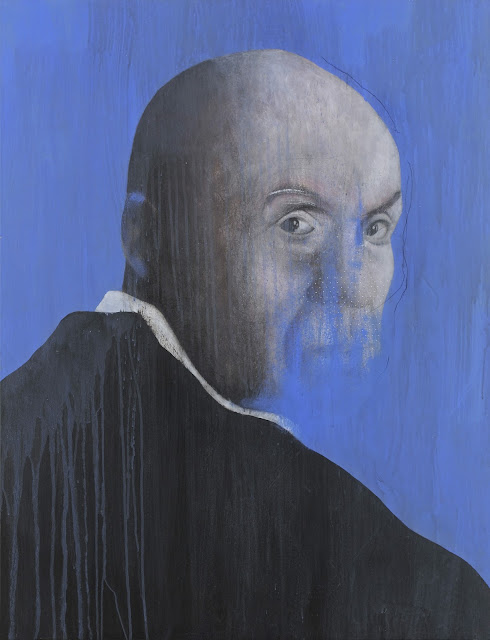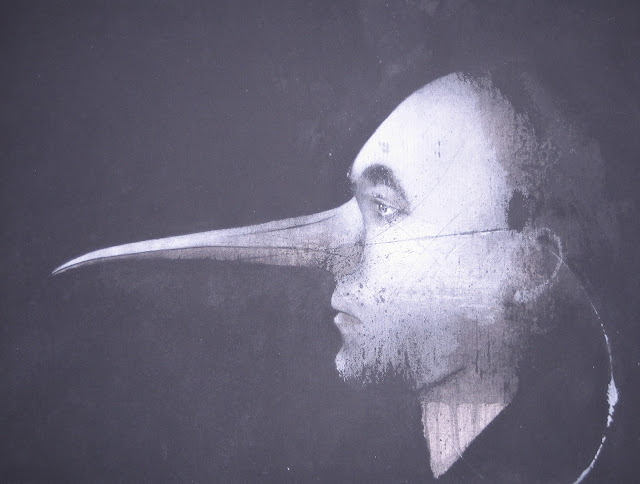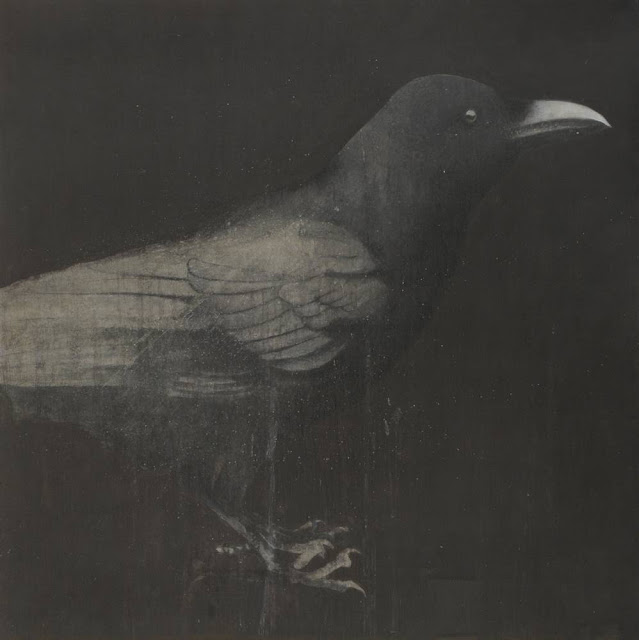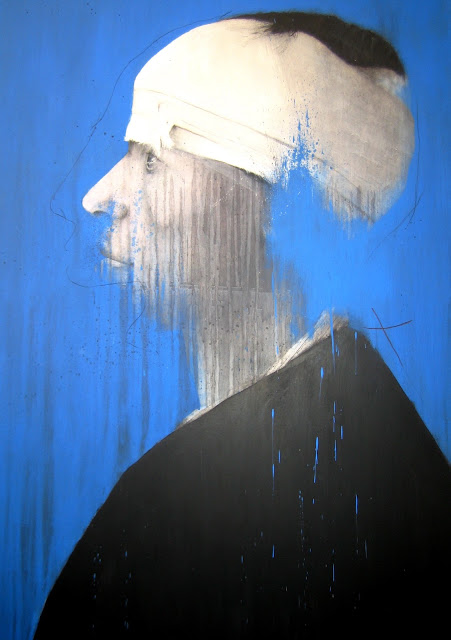Lucas Weinachter
Né le 27 décembre 1959, Lucas Weinachter vit et travaille à Paris
Avec ses derniers paysages, Weinachter nous avait entraînés dans un monde où une lumière sourde habitait les ombres de lieux graves et chargés de mystères. Il observait des horizons où la profondeur des noirs le disputait aux gris lumineux. C’est une identique précision qui guide le trait et sa palette est toujours aussi resserrée, quasi monochrome quand il scrute des visages, avec la même minutie et la même patience.
Les visages se font souvent face dans une introspection, un q uestionnement fait d’allers et retours permanents entre eux et eux, entre eux et nous. Ces hommes et ces femmes sont anonymes, au vrai sens du terme, et pourtant nous les connaissons tous sans pourvoir leur appliquer la moindre identité. Ils sont nous, nous sommes eux. Weinachter peint sans modèle. Il est seul à l’atelier avec des documents photographiques, souvent volontairement dégradés. Ici, ce sont des images anthropométriques qui ont orienté le travail. La rigueur des cadrages face/profil, la froideur des regards, le détachement, c’est juste un enregistrement du visage qui sert de point de départ.
Tout l’art du peintre sera d’aller chercher l’humanité, de la révéler, de l’interroger. Il faut faire disparaître les traits pour mieux les faire parler, guetter l’imperfection, la particularité, interroger l’autre, se retrouver dans un autre soi-même, se confronter. Il est donc naturel que la mélancolie s’installe dans ce dialogue entre plusieurs soi-même. C’est d’avantage un spleen baudelairien qu’une tristesse pathologique, c’est une tentative de prise de conscience qui laisse de côté une insouciance et une désinvolture qui ne sont plus de mise. Il y a une forme de désenchantement dans l’œuvre qui la rend grave et puissante.
C’est aussi une renaissance qui nous est proposée. D’ailleurs, regardez bien cette toile très claire où un homme en chapeau semble à peine esquissé. Regardez-le longuement, attentivement. Au début vous pensiez qu’il était en train de disparaître, les traits mangés par la lumière. En fait, il n’en n’est rien. L’homme au chapeau apparaît. Il se révèle comme dans un bain photographique et voilà qu’à son tour, c’est lui qui vous regarde, vous scrute, vous détaille avec tant d’insistance qu’il doit sans aucun doute…vous connaître.
Philippe Bréson
Facebook Page![]()
![]()
![]()
![]()
![]()
![]()
![]()
![]()
![]()
![]()
![]()
Dans les années 1990, Lucas Weinachter (né en Lorraine en 1955) inaugure une carrière soutenue et encouragée par Louis Pons, dans l’art singulier des « reliquaires », assemblages de végétaux, d’objets hétéroclites ou organiques, de vieux papiers, d’ossements combinés sous globes de verre. Les objets trouvés au fil des années pour composer ses boîtes fantastiques, en volume, ont simultanément nourri les dessins et la peinture.
Il isole au fil du temps les objets destinés aux assemblages et commence à les déformer selon le principe de l’anamorphose, flirtant ainsi avec l’abstraction. Lorsque l’aventure des boîtes s’épuise à Paris, à la fin des années 1990, la peinture a déjà réinvesti l’atelier parisien de l’artiste. De la densité décorative des assemblages, à la morbidité esthétisante, qui fonctionnent comme des mises en scènes théâtrales, l’œuvre de Lucas bascule pour imager le silence et le vide à travers la « brutalité » d’une image simple et sans détour.
Les « Mélancolies » d’aujourd’hui, profils d’hommes et de femmes sur grands formats, dessinés à la mine de carbone et à la mine de plomb sur toile, rehaussés d’acrylique, succèdent à toute une série de natures mortes et de paysages, représentés par la galerie Felli depuis 2004. Ils mettent l’accent sur le visage, une nuque, de corps anonymes photographiés autrefois au profit de l’étude et de la recherche scientifique.
Les visages de la série ont été inspirés par une série de photographies anthropométriques. Lucas Weinachter précise qu’il puise depuis toujours son inspiration dans toute une série de documents qui datent des débuts de la photographie. En 1980, Lucas intègre l’école des Beaux-Arts de Paris, où il étudie l’architecture jusqu’en 1982. Cette orientation qui est un « choix dirigé » l’éloigne à peine de ses premiers penchants, puisque – peintre et dessinateur d’origine – il prend simultanément des cours de peinture à l’atelier de Vladimir Velickovik et éprouve la nécessité d’étudier l’anatomie : « Après avoir travaillé sur le corps et l’anatomie, il était normal que le visage m’intrigue » annonce Lucas Weinachter, comme pour justifier la présence des « Mélancolies » récentes dans son parcours.
Comparant ses « anthropomorphies » à des corps « inertes », ou plutôt immobiles, semblables aux moulages du XIXe siècle, il leur redonne aujourd’hui un visage, visage avant tout sélectionné pour ses particularités physiques : « Comme pour le corps, je ne suis pas à la recherche d’un esthétisme de pose, mais davantage de curiosités, de particularités dans un visage. » L’être humain appréhendé comme une « curiosité », Weinachter s’en est servi pour fixer sur la toile, la perte voire l’absence d’une identité qu’il questionne. Sans nostalgie, sans peine et sans regret, il réintroduit la mélancolie dans son antique définition : « Aujourd’hui on ne veut plus regarder la mélancolie (…) On l’associe hâtivement à la tristesse pour s’en débarrasser au plus vite (…) J’aime la définition de la mélancolie dans la pensée antique : elle signifiait un état qui permettait de vivre, de se dépasser, de chercher un sens à sa vie ce que nous faisons tous. »
Formaliste avant tout, la série est l’occasion pour Weinachter de couper, cadrer, tronquant ici et là, le nez d’un homme comme il tronque un peu plus loin le bec et la queue d’un corbeau, ces « oiseaux de mauvais augure, moi je trouve surtout qu’ils nous narguent en permanence… ». Il établit des face à face intrigants (en diptyque, donnant à voir un reflet inexact), cultive l’étrangeté d’une figure au caractère mélancolique et imagine – pour nous éclairer – des contours qu’il appelle « ruptures » : Corbeaux, Mémento Mori, Métaphore du sommeil, de l’éveil ou de l’endormissement. Cette série dans la série, intitulée « L’Antichambre », présente un personnage masqué de profil qui, initialement assis sur une chaise dans une atmosphère nocturne, se redresse, s’éveille, « prend conscience » pour l’artiste. Nous sommes ainsi invités à observer un jeu de miroir auquel nous sommes à peine conviés.
Au fil de la série, la problématique de l’état d’âme émerge des velours mats, noirs, sépias et gris de Lucas Weinachter : « Je ne voulais pas faire apparaître les numéros qui existent traditionnellement pour identifier ces images. Mon choix a aussi été guidé par la particularité de l’expression (ridicule parfois) mais toujours empreinte d’une sorte de gravité, une mélancolie, à l’image de la société aujourd’hui. »
Mais en réalité, Weinachter, exécute un léger retour en arrière avec ces visages qui nous transportent dans l’entre-deux-guerres et il continue de fixer les traces ou empreintes d’un passé peu lointain, invitant objets, animaux, silhouettes masquées, visages de face, de dos, de profil, à livrer le même récit.
Enfant, Lucas bénéficiait de balades dans les campagnes vallonnées de Lorraine, épaulées des récits historiques transmis par son grand-père instituteur. Au rythme de la narration, le paysage, balisé d’arbres se transforme et laisse « entrevoir » les stigmates des incursions militaires récentes. L’impression produite par le récit transforme peu à peu le regard que le jeune dessinateur pose sur le paysage jusqu’alors familier qui livre soudainement les vestiges de ses tourments passés. C’est ainsi qu’à partir des motifs les plus simples qui soient, Lucas Weinachter réintroduit une présence à peine perceptible ou identifiable qu’il nous faudra nous-même nommer, comme les hommes et femmes des « mélancoliques ».
Et quel que soit le sujet abordé, Lucas Weinachter fixe pour toujours le temps qui, lui aussi, ne fait que passer sur l’insignifiant. Il revisite les paysages, de son enfance, une assiette, un tabouret, une fleur séchée, en les chargeant d’âme, comme s’il fixait une forme de déclin dont il ne faut cependant aucunement s’attrister. À travers la figure humaine, aujourd’hui, il nous révèle une fois encore son unique sujet : celui de la vanité.
source
.jpg)
.jpg)
.jpg)
.jpg)
.jpg)
.jpg)
.jpg)
.jpg)
.jpg)
.jpg)
.jpg)
.jpg)
.jpg)
.jpg)
.jpg)
.jpg)
.jpg)
.jpg)
.jpg)
.jpg)
.jpg)
.jpg)
.jpg)
.jpg)
.jpg)
.jpg)
.jpg)
.jpg)
.jpg)
.jpg)
.jpg)
.jpg)
.jpg)
.jpg)
.jpg)
.jpg)
.jpg)
.jpg)
.jpg)
.jpg)
.jpg)
.jpg)
.jpg)
.jpg)
.jpg)
.jpg)
.jpg)



































.jpg)
.jpg)
.jpg)
.jpg)
.jpg)
.jpg)
.jpg)
.jpg)
.jpg)
.jpg)
.jpg)
.jpg)
.jpg)
.jpg)
.jpg)
.jpg)
.jpg)
.jpg)
.jpg)
.jpg)

.jpg)
.gif)
.jpg)
.jpg)
.jpg)
.jpg)
.jpg)
.jpg)
.jpg)
.jpg)
.jpg)
.jpg)
.jpg)
.gif)
.jpg)
.jpg)
.jpg)
.gif)
.gif)
.gif)
.jpg)
.jpg)
.jpg)
.jpg)
.jpg)
.jpg)
.jpg)
.jpg)
.jpg)
.jpg)


.jpg)
.jpg)
.jpg)
.jpg)
.jpg)
.jpg)
.jpg)
.jpg)
.jpg)
.jpg)

.jpg)
.jpg)
.jpg)
.jpg)
.jpg)
.jpg)
.jpg)
.jpg)
.jpg)
.jpg)
.jpg)
.jpg)
.jpg)
.jpg)
.jpg)
.jpg)
.jpg)
.jpg)
.jpg)
.jpg)
.jpg)
.jpg)
.jpg)
.jpg)
.jpg)
.jpg)
.jpg)
.jpg)
.jpg)
.jpg)
.jpg)
.jpg)
.jpg)
.jpg)
.jpg)
.jpg)
.jpg)
.jpg)
.jpg)
.jpg)
.jpg)




.jpg)
.jpg)
.jpg)
.jpg)
.jpg)
.jpg)
.jpg)
.jpg)
.jpg)
.jpg)
.jpg)
.jpg)
.jpg)


.jpg)
.jpg)
.jpg)
.jpg)
.jpg)
.jpg)
.jpg)
.jpg)
.jpg)
.jpg)
.jpg)
.jpg)
.jpg)
.jpg)
.jpg)
.jpg)
.jpg)
.jpg)
.jpg)
.jpg)
.jpg)
.jpg)
.jpg)
.jpg)
.jpg)
.jpg)
.jpg)
.jpg)
.jpg)
.jpg)
.jpg)
.jpg)
.jpg)


.jpg)
.jpg)
.jpg)
.jpg)
.jpg)
.jpg)
.jpg)
.jpg)
.jpg)
.jpg)
.jpg)
.jpg)
.jpg)
.jpg)
.jpg)
.jpg)
.jpg)
.jpg)
.jpg)
.jpg)
.jpg)
.jpg)
.jpg)
.jpg)
.jpg)
.jpg)
.jpg)
.jpg)
.jpg)
.jpg)
.jpg)
.jpg)
.jpg)
.jpg)
.jpeg)
.jpg)
.jpg)
.jpg)
.jpg)
.jpg)
.jpg)
.jpg)
.jpg)
.jpg)
.jpg)
.jpg)
.jpg)
.jpg)
.jpg)
.jpg)
.jpg)
.jpg)
.jpg)
.jpg)
.jpg)
.jpg)
.jpg)
.jpg)
.jpg)
.jpg)
.jpg)
.jpg)
.jpg)







































.jpg)
.jpg)
.jpg)
.jpg)
.jpg)
.jpg)
.jpg)
.jpg)
.jpg)
.jpg)
.jpg)
.jpg)
.jpg)